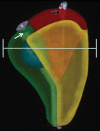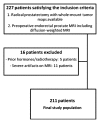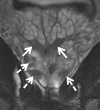Normal central zone of the prostate and central zone involvement by prostate cancer: clinical and MR imaging implications
- PMID: 22357889
- PMCID: PMC3285222
- DOI: 10.1148/radiol.11110663
Normal central zone of the prostate and central zone involvement by prostate cancer: clinical and MR imaging implications
Erratum in
- Radiology. 2012 Aug;264(2):617
Abstract
Purpose: To describe the anatomic features of the central zone of the prostate on T2-weighted and diffusion-weighted (DW) magnetic resonance (MR) images and evaluate the diagnostic performance of MR imaging in detection of central zone involvement by prostate cancer.
Materials and methods: The institutional review board waived informed consent and approved this retrospective, HIPAA-compliant study of 211 patients who underwent T2-weighted and DW MR imaging of the prostate before radical prostatectomy. Whole-mount step-section pathologic findings were the reference standard. Two radiologists independently recorded the visibility, MR signal intensity, size, and symmetry of the central zone and scored the likelihood of central zone involvement by cancer on T2-weighted MR images and on T2-weighted MR images plus apparent diffusion coefficient (ADC) maps generated from the DW MR images. Descriptive summary statistics were calculated for central zone imaging features. Sensitivity, specificity, and area under the curve were used to evaluate reader performance in detecting central zone involvement.
Results: For readers 1 and 2, the central zone was visible, at least partially, in 177 (84%) and 170 (81%) of 211 patients, respectively. The most common imaging appearance of the central zone was symmetric, homogeneous low signal intensity. Cancers involving the central zone had higher prostate-specific antigen values, Gleason scores, and rates of extracapsular extension and seminal vesicle invasion compared with cancers not involving the central zone (P < .05). Area under the curve, sensitivity, and specificity in detecting central zone involvement were 0.70, 0.30, and 0.96 for reader 1 and 0.65, 0.35, and 0.93 for reader 2, and these values did not differ significantly between T2-weighted imaging and T2-weighted imaging plus ADC maps.
Conclusion: The central zone was visualized in most patients. Cancers involving the central zone were associated with more aggressive disease than those without central zone involvement.
© RSNA, 2012.
Figures













References
-
- McNeal JE. Regional morphology and pathology of the prostate. Am J Clin Pathol 1968;49(3):347–357 - PubMed
-
- Hricak H, Dooms GC, McNeal JE, et al. MR imaging of the prostate gland: normal anatomy. AJR Am J Roentgenol 1987;148(1):51–58 - PubMed
-
- Sommer FG, McNeal JE, Carrol CL. MR depiction of zonal anatomy of the prostate at 1.5 T. J Comput Assist Tomogr 1986;10(6):983–989 - PubMed
-
- McNeal JE, Redwine EA, Freiha FS, Stamey TA. Zonal distribution of prostatic adenocarcinoma: correlation with histologic pattern and direction of spread. Am J Surg Pathol 1988;12(12):897–906 - PubMed
-
- Noguchi M, Stamey TA, Neal JE, Yemoto CE. An analysis of 148 consecutive transition zone cancers: clinical and histological characteristics. J Urol 2000;163(6):1751–1755 - PubMed
Publication types
MeSH terms
Grants and funding
LinkOut - more resources
Full Text Sources
Other Literature Sources
Medical

